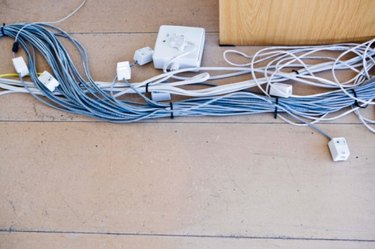
Finding the origination point of wires and cabling installed in your home can be a difficult task. With the wires disappearing into walls and ceilings, finding the correct wires can become a frustrating guess-and-test exercise. Using a wire tracer takes the guesswork out of finding and identifying wires. Wire tracers are easy to use, inexpensive and available at home improvement stores.
Step 1
Use a circuit tester to ensure the cable or wire to be traced is de-energized. Disconnect the end of the wire or cable from the terminal or outlet it is connected to or use the appropriate connector to plug the wire tracer into the terminal or outlet. Attach the clips from the tone generator to the disconnected wire or cable if an adapter is not used. Connect one clip to the wire and the other clip to a ground wire, if present. Attach both clips to the disconnected wires if no ground is present.
Video of the Day
Step 2
Press the On/Off button on the transmitter once to activate the tone generator. Check the LED on the front of the transmitter; if it's blinking, the transmitter is working properly.
Step 3
Hold the end of the wire tracer near the transmitter while pressing and holding the On/Off button on top of the tracer. Listen for a warbling sound from the tracer and adjust the sensitivity wheel on the tracer until the sound can be heard clearly.
Step 4
Hold the end of the tracer against the wire that is believed to be the origination point of the wire that the transmitter is connected to. Listen for a warbling sound from the tracer. Test other suspect wires if no clear sound is heard from the tracer. Mark the wire to make future identification easier if the warbling is heard.
Step 5
Perform continuity tests on the suspect wires if no warbling is heard from any of them as breaks in the lines will prevent the transmitter from sending a clear signal. Repair any breaks in the wires or cables and perform the wire tracing steps again.
Tip
A wire tracer can work from up to a foot away from the wire the transmitter is connected to, allowing you to find the wire behind walls and ceiling panels.
Warning
Never attempt to test live circuits with the wire tracer as this can cause dangerous shocks and damage the transmitter.
Never test sensitive vehicle circuits such as airbag or computer circuits as the voltage created by the transmitter could damage vehicle components.
Video of the Day